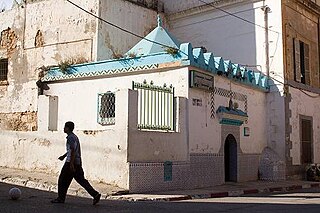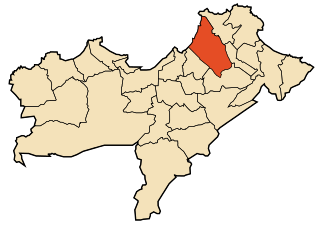
Mostaganem is a province (wilaya) of Algeria. Its capital is Mostaganem.

As the tenth-largest country in the world, and the largest in Africa and in the Mediterranean region, Algeria has a vast transportation system that includes a large and diverse transportation infrastructure.

Oran is a major coastal city located in the north-west of Algeria. It is considered the second most important city of Algeria after the capital Algiers, due to its population and commercial, industrial, and cultural importance. It is 432 km (268 mi) west-south-west from Algiers. The total population of the city was 803,329 in 2008, while the metropolitan area has a population of approximately 1,500,000 making it the second-largest city in Algeria.
Articles related to Algeria include:

Mostaganem is a port city in and capital of Mostaganem province, in the northwest of Algeria. The city, founded in the 11th century lies on the Gulf of Arzew, Mediterranean Sea and is 72 km ENE of Oran. It is considered as the second-largest city in the country's northwest, after Oran, and as Algeria's fourth-largest port city with its 457,986 inhabitants as of the 2018 census.

Arzew or Arzeu is a port city in Algeria, 25 miles (40 km) from Oran. It is the capital of Arzew District, Oran Province.

Tiaret is a major city in northwestern Algeria that gives its name to the wider farming region of Tiaret Province. Both the town and region lie south-west of the capital of Algiers in the western region of the Hautes Plaines, in the Tell Atlas, and about 150 km (93 mi) from the Mediterranean coast. It is served by Abdelhafid Boussouf Bou Chekif Airport.

Oran Province is a province (wilayah) in Algeria whose seat is the city of the same name.

Ténès is a town in Algeria located around 200 kilometers west of the capital Algiers. As of 2000, it has a population of 65,000 people.

Sidi El Houari was an Algerian imam whose real name was Ben-Amar El Houari. He is the patron saint of the city of Oran in Algeria. The old quarter of Sidi El Houari in Oran is named after him.

Bethioua is a town and region in the wilaya of Oran in the west of Algeria. It has a gas port, petrochemical facilities and desalination plant.

Zemmouri is a town and commune in the Bordj Menaïel District of Boumerdès Province, Algeria. As of 2008, the population of the municipality is 26,408.

Gdyel, former Saint-Cloud, is a town and commune in District Gdyel, Oran Province, Algeria, about 15 miles to the east of Oran. Under French rule, it was the centre of a wine-growing district and was called St. Cloud.
Oued Essalem is a town and commune in Relizane Province, Algeria. According to the 2008 census, it has a population of 9319. It was previously named Henri Hoc under French colonization. The commune is located in the south-west of its province, it spans over 292.95 km2 and the Manesfa River passes through it, it is the largest commune by area of its district. It is linked by the RN23, and is a stop between the large cities of the west, Tiaret, Oran and Mostaganem, it also possesses a departemental road linking it with the town of Oued El Abtal. Located 100 km away from the Mediterranean Sea, Oued Essalem experiences a warm and dry climate, with a slight alpine tendency, its winters are often rainy, and snowfall can sometimes occur.

Honaine is a town and commune in Tlemcen Province in northwestern Algeria.

Drinking water supply and sanitation in Algeria is characterized by achievements and challenges. Among the achievements is a substantial increase in the amount of drinking water supplied from reservoirs, long-distance water transfers and desalination at a low price to consumers, thanks to the country's substantial oil and gas revenues. These measures increased per capita water supply despite a rapidly increasing population. Another achievement is the transition from intermittent to continuous water supply in the capital Algiers in 2011, along with considerable improvements in wastewater treatment resulting in better water quality at beaches. These achievements were made possible through a public-private partnership with a private French water company. The number of wastewater treatment plants throughout the country increased rapidly from only 18 in 2000 to 113 in 2011, with 96 more under construction. However, there are also many challenges. One of them is poor service quality in many cities outside Algiers with 78% of urban residents suffering from intermittent water supply. Another challenge is the pollution of water resources. There has also been insufficient progress concerning reuse of treated water, a government priority in this dry country.
The following is a timeline of the history of the city of Oran, Algeria.

Portus Magnus was a Roman port in western Mauretania Caesariensis. It was located near Roman Portus Divinus and actual Oran (Algeria).

The Beylik of the West was one of three Beyliks (governorates) of the Regency of Algiers, with the other two being the Beylik of Titteri and the Beylik of Constantine. It was established in 1563, and it was ended during the French conquest.


















